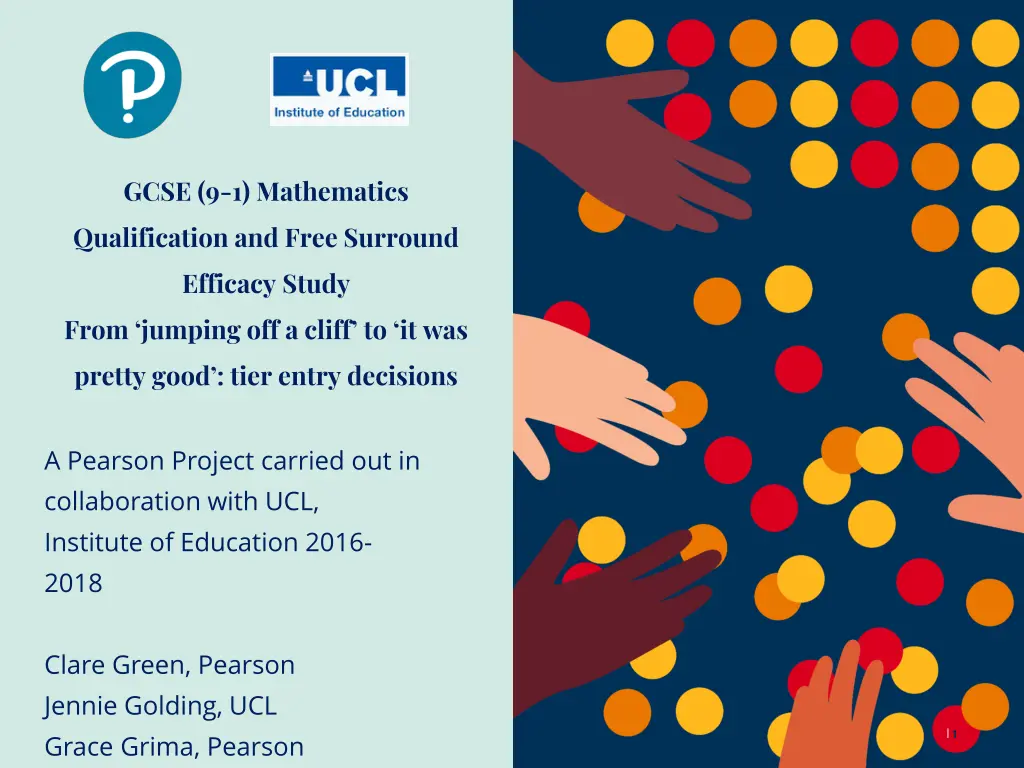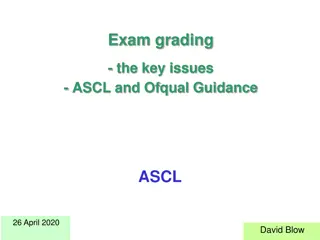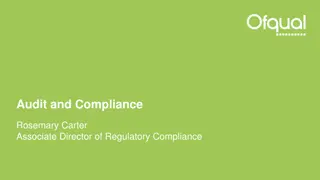
GCSE Mathematics Qualification Study
This study conducted in collaboration with UCL explores the efficacy of the GCSE Mathematics Qualification and Free Surround in enhancing learner outcomes across ability ranges. The research methodology involved recruitment of schools, interviews with teachers and students, analysis of results, and progression interviews. The study aims to provide insights into assessment design, learner access, and progression opportunities in mathematics education.
Download Presentation

Please find below an Image/Link to download the presentation.
The content on the website is provided AS IS for your information and personal use only. It may not be sold, licensed, or shared on other websites without obtaining consent from the author. If you encounter any issues during the download, it is possible that the publisher has removed the file from their server.
You are allowed to download the files provided on this website for personal or commercial use, subject to the condition that they are used lawfully. All files are the property of their respective owners.
The content on the website is provided AS IS for your information and personal use only. It may not be sold, licensed, or shared on other websites without obtaining consent from the author.
E N D
Presentation Transcript
GCSE (9-1) Mathematics Qualification and Free Surround Efficacy Study From jumping off a cliff to it was pretty good : tier entry decisions A Pearson Project carried out in collaboration with UCL, Institute of Education 2016- 2018 Clare Green, Pearson Jennie Golding, UCL Grace Grima, Pearson 1
The policy context New National Curriculum in Mathematics rolled out from late 2014. More aspirational content. ..together with a renewed focus on problem solving and reasoning. We have little experience of (teaching and) assessing for those across the range of students. First GCSE examinations Summer 2017: as previously, Foundation and Higher tiers. New grading structure: Foundation targets 1- 5 and Higher targets 4-9, with an allowed 3. 2
Learner outcomes informing research design Category Outcome Learners across the ability range have opportunities to demonstrate their mathematical abilities Definition There are no barriers limiting access for those whose ability falls within the grade range. Learners are assessed at the appropriate grade. Learners are able to access the free surround materials to ensure equity and access for all Learner access and experience Free surround materials include the learner-facing materials, the teacher-facing materials (both physical and online) and the CPD Learners are supported to achieve their potential by the design of the assessment materials There are no barriers in terms of assessment design which act as barriers to learners in accessing the items and their meaning. This will include the language used in assessments. The qualification provides a strong foundation for further academic and vocational study and for employment and training. This includes level 3 maths courses alongside subjects where the understanding and application of maths is crucial. GCSE mathematics does, by definition, enable progression. The confidence of the students is related to the WCQ comparability as learners can be confident that they are at a grade comparable with the top performing jurisdictions. The qualification is effective in allowing learners to progress to further study, training or work Learner progression
Methodology End of 2016 Recruitment of Edexcel Mathematics GCSE centres: Stratified sample of 20 schools to recruit 40 year 11 classes of a variety of target GCSE grades; HoD plus one F and one H entry class, and their teachers. Visits: Interviews with each tier teacher and HoM; focus group with 4 students from each class. 2 x whole-class written surveys. Experience of free surround and perceptions of examination papers. Telephone interviews with HoM: Analysis of GCSE 2017 results and reflection on those. Progression interviews for post-16 in 11-18 schools: teacher interviews with teachers of a range of Ma and Ma-intensive courses; range of student focus groups Year 1: Spring 2017 October 2017 Late Autumn201 7 Year 2: 2018 As for year 1, for second GCSE cycle. What s the same, what s different and any other probes suggested from first year. 4
Data year 1 Sample of 18 schools from initial recruitment stratified by school size, catchment type, GCSE outcomes, SES, Ofsted rating, governance and structure. Interviews with 18 Heads of Maths approach and confidence. 36 focus groups with Higher tier and Foundation tier students in Y11. Interviews with 18 Higher and 18 Foundation tier teachers. Surveys with over 1600 Y11 students. 5
Confidence I don t feel I ve got a clue Struggling A gamble Totally unconfident, nervous as hell, would like to jump off a cliff A guessing game 6
Imposing old ideas onto new system Do I put them on the Foundation where I know they ll definitely get a 4 or a 5, but it won t be challenging for them, or put them on the Higher where maybe they might be able to get a 6 but if they have a bad day, then they could get a U? We did look at Foundation for two or three girls in the lower set and in fact they did the Foundation, needing the high mark, in January. But they did better overall on the Higher paper than they did the lower paper. And our experience previously is the person has to get so many marks to get a C in a Foundation that we re better off doing the Higher where they can concentrate on a small section (of maths) and just get that few marks, so we ve stuck with Higher. 7
Lacking information around the grade boundaries 1 because I don t know the grade boundary, I can t risk it. the danger is some of our pupils unfortunately might fall off the Higher paper because they can t get enough marks on it 8
Lacking information around the grade boundaries 2 Last year every group bar one sat the Higher paper, because we felt kids could access the Higher paper. ...Last year we had six groups, so five took them and we had a very weak nurture group who'd sat the Foundation; because we felt the old Edexcel papers, just about every student could access the Higher paper, even very weak students could get grades off them, that's certainly not the case with this paper. So now, .(of) seven groups we have, only two are going for the Higher paper. ..it's quite a shift. Now, possibly, retrospectively I may have gone with three groups but because we were a bit unsure whether they could access a Higher paper they followed a Foundation scheme at work; looking back now they probably could have done it. But certainly, I don't think we'll ever get to a stage, certainly in my time very soon where the majority will be doing Higher. 9
Late decisions We've not made final tier decisions. I was changing them probably on the last day that we could without any charge 10
Student experience I m okay this year, I think, because I know that they can award a four from Higher but really if a child was only going to be capable of achieving a four, I would no way put them in for Higher because their experience of the maths is: I can do 10% of it, god, maths must be awful, aren t I stupid? I prefer them to have a successful feeling and coming out of a maths exam being able to do all of it, not just some of it. 11
Impact of multiple changes at same time My Foundation group, I think historically, would have been sitting the Higher paper because they are, your C/D borderline students, if we could take, go back a year... So last year, we would have definitely been entering them into the Higher. They're capable of that, accessing some of that maths, but it's got so much more difficult and we don't want C/D borderline students, if we want to talk old money, generally struggle with the wordy questions and all the, and the understanding and some of the harder maths. So it's the gamble, do we put them in the Higher and where they'll have to do less maths? 12
Naming of tiers Why couldn t they call it Core and Extension or ?...It's language makes difference psychologically. just that much so It s a big thing here to get to fall off the scale of the Higher tier. It s never happened since I ve been here. ...The girls tend to feel a little self-conscious if there s anybody who is put in for Foundation, but that s a peer pressure thing 13
After the event: For some, (a move to) enter for H only if a potential 6+ We re going to be moving, as are a lot of other schools, to more Foundation entries next year. So unless a student is likely or aiming for six, we re going to be putting them in for Foundation . We have prepared them for the fact that now, unless you re going for the six, you re looking at Foundation. So that they know what s more likely, in that if they want to go beyond that, they re going to work. 14
Entering for Foundation boosts the chance of getting a 5 I think it was more difficult to get a 5 on the Higher paper. students in the Higher paper that were probably around a level 5 found it harder to get a 5 on the Higher paper because they found it hard to score enough marks. Those of similar ability we put into the Foundation paper did get 5s. I think our We had four students who we dropped to Foundation, because they were not getting a grade 4 at the Higher. So we dropped them to Foundation, and they all got grade 5 . 15
But sometimes 4+ trumps: entering for Higher it s easier to get a 4 Previously Foundation when we ve had students who we think are borderline. But, actually, we think given the work we ve done with them, it s more likely they re going to just get in on the Higher paper. Rather than having to do so much better on the Foundation we have considered right on the We're probably going to try and put our set four or set three into Higher if we can, this year, but only Foundation for the absolutely... Because of the grade 4s that you can get on Higher 16
Centrality of Value Added and other performance measures, especially for leadership If they were on level 5 (at Key Stage 2) , they had to be sitting Higher paper. . If they were .a 4.6 kid at key stage 2 .then obviously we didn t want to shoot ourselves in the foot by restricting them with a Foundation paper, because they wouldn t get the attainment that s needed for them to get a positive progress. Because the Higher was so inaccessible to your low high ability students, or your (former) low Higher tier students, we had no choice but to enter them for Foundation, but it has had a negative impact on our progress. Progress score this year was... We've just broke even. It's zero. And last year, it was 0.19. 17
Parental influence either way A lot of parents put pressure on for us to enter their child for Foundation, because all their child needs (is a) pass, which then restricts the progress of the student. One issue that we do have is because it was labelled Foundation and Higher a lot of our parents don't want their children to sit Foundation due to the stigma attached to the word Foundation from historical years where it used to be a three tier. Parents think because it s Foundation their child's no good at maths and that s the difficulty we have, is that a lot of parents want to make their child sit Higher . 18
Listening to student preferences, concerns about student experiences and mental health And also what the girls want. You know, if they think, no, I don't want to try, Higher I'll do Foundation, they... we let them. did involve decision. Some of them felt more confident doing Higher, or were desperately keen to do Higher. Some lack the confidence and felt more secure doing Foundation, so we do take that perspective into account. We the students in that I think it's difficult to judge if they'd have done as well if we'd have just ploughed on with the Higher. And would we have got a few more 6s? I don't know, but for us, when you're giving a student a Higher paper and they're getting upset, that was doing a detriment to their mental health. So we looked at the individual students Realistically, you know, we don't want these kids coming out of their first exam, going, there's no point. So we went on the side of the human side, rather than trying to push for results. And actually, we still got results. 19
For many middle students, H tier entry separated from a H curriculum Strategic approach: increased coaching for likely common questions (at least 6 schools). Inevitably this impacts on student preparedness for appropriate progression: We think that's the way to go to just start preparing them a bit more for common questions . We had to drop those that we were scared would fail on the Higher down to the Foundation, which caps them. And some of consequently underperformed Foundation as well, because they were intelligent students thought, it's going to be easy. And it wasn't easy. Now we've got a past set of papers we ll make them do all the rest of the questions that will be on the Foundation tier, on the Higher tier and then make a judgement based on that . those then on and they just But (one school) This year we ve got four sets so two are doing Higher and two are doing Foundation. most of it s already decided: that s how we re teaching them. So, 20
Reflection and next steps Re-naming tiers ( Core and Extension ?) might address psychological resistance to better alignment of curriculum intentions with tier entry. Schools found the non-piloted introduction of the GCSE exams, with new grade structures, very stressful, though are getting to grips with the implications. The combination of new curriculum emphases and question types alongside lack of knowledge and understanding of grade boundaries, was challenging. A widespread disjuncture between tier entry and curriculum studied means mastery of mathematical functioning is undermined as a curriculum goal. That is exacerbated by any perceived incentive to enter at Higher. Existence of allowed grade 3 on Higher might be supporting strategic entry at Higher. Mixed picture re next year s entries suggests maybe equivalence of different routes to a grade is becoming better recognised. We re exploring student experiences of tier entry in the second year of this study, including parental voice. 21
Appendix 1: Heads of Mathematics Years as HoM 17 7 2 2 4 14 9 10 3 6 15 2 4 2 3 9 1 8 GCSE Currently teaching Foundation (F) or Higher (H) H F Both F/H mixed (always middle) H (grammar school) Both F (plus some of a H class) Both F H Both F except for 2 students Both Both H Both F H School Edexcel (yrs) teaching (yrs) 20 20 20 8 29 29 20 17 11 >20 23 10 8 10 3 16 3 12 1 2 3 4 6 7 8 9 10 11 12 13 14 15 16 17 18 19 20 7 20 4 29 10 or 12 20 11 10 >20 17 10 8 10 10 16 2 9 22
Appendix 2: Reports produced Internal technical report for Phase 1 (to August 2017): Green, C., Golding, J. and Grima, G. (2017). GCSE 9-1 Mathematics qualification and free surround efficacy study: Phase 1 report. London: Pearson. This has informed details of approaches to Summer 2018 papers. Summary report for Phase 1. Phases 1-3 internal and summary reports (to August 2018) will be produced in Autumn 2018. Final report will be produced early in 2019. 23






















